 Years ago, I received two mini hot water bottles from my sister. They had plain knitted covers. One of them was red with a white heart on the front, and the other had the same knitted cover with the colors inverted. (They were too cute together for my sister to buy only one of them!) This memory and the fact that winter is fully upon us are what sparked this project. My hot water bottles were smaller than regular hot water bottles, but not as small as this cookie, which is the size of a hand warmer.
Years ago, I received two mini hot water bottles from my sister. They had plain knitted covers. One of them was red with a white heart on the front, and the other had the same knitted cover with the colors inverted. (They were too cute together for my sister to buy only one of them!) This memory and the fact that winter is fully upon us are what sparked this project. My hot water bottles were smaller than regular hot water bottles, but not as small as this cookie, which is the size of a hand warmer.
I haven't seen this cookie shape or concept before, so I hope I have brought you something different. The knitting decoration on top is not new, however; in fact, it's very popular, especially at this time of year. Such knit decorations can range from quite intricate and realistic, as demonstrated by Sonja Galmad (aka @iSugarfy (aka swissophie), here) and Evelin Milanesi (aka @Evelindecora, here), to more minimalistic, like those I've piped in this tutorial or other stenciled patterns found online. This is my personal take, very similar to the royal icing knot I made in my June tutorial, but less complicated because the pattern here is relatively straight with only slight curves.
- 1 (5.8 x 10.7-cm/2 1/4 x 4 1/4-in) hot water bottle cookie, flooded with white royal icing and completely dry (You’ll find my cookie template in "Attachments" under "Files" at the end of this post.)
- Cable-knit pattern template (Also under "Attachments", in the same file noted above.)
- Edible food marker
- Royal icing and pastry tips:
- White piping-consistency with PME #1 tip or equivalent
- White thick flooding-consistency with Wilton #2 tip or equivalent (To avoid cratering, be sure to keep this icing on the thick side.)
Step 1: Trace, outline, and flood cable-knit pattern
a. Set the iced (and completely dry) hot water bottle cookie on your work surface. Using the cable-knit pattern template as a visual guide, draw the pattern on top of your cookie with an edible food marker. (If you'd prefer not to draw freehand, project and trace the pattern, or transfer it using the paper transfer technique described by @Dolce Sentire - Aixa Zunino here in Step 1.)
b. Using white piping-consistency royal icing and a PME #1 tip (or equivalent), pipe over the outlines of the pattern you drew in Step 1a. Then pipe two parallel lines on each side of the cable-knit pattern. These lines will form the boundaries of two stripes that will be flooded in the next step. (I found it easier to pipe these lines directly on the cookie without marking them beforehand. But, feel free to draw them first if you like.)
c. Using white thick flooding-consistency royal icing and a Wilton #2 tip (or equivalent), flood the sections of the cable-knit pattern. First flood non-adjacent sections; then allow a little drying time before piping the remaining sections in Step 1d. (Allowing the icing to crust will ensure that each section remains distinct.) In the meantime, flood the stripe on each side of the cable-knit pattern.
d. Finish by flooding the remaining sections of the cable-knit pattern. Let the icing dry completely.
Step 2: Pipe decorative lines
a. Using white piping-consistency royal icing and a PME #1 tip (or equivalent), pipe a central line along the two leads (strands) of the cable-knit pattern, and along the two lateral stripes. Of course, stop piping the line wherever the two leads cross each other, but then resume piping after those intersection points.
b. Now, using the central line you just piped as a visual guide, pipe two parallel lines (one on each side of the central line) on one of the lateral stripes. Do the same along one of the leads of the cable-knit pattern.
c. Repeat the first part of Step 2b for the other stripe.
d. Repeat the latter part of Step 2b for the remaining lead in the cable-knit pattern.
Step 3: Decorate bottle "neck"
a. Outline and flood the “neck” of the hot water bottle as shown below, and let the icing dry. (Again, use piping-consistency royal icing for outlining, and thick flooding-consistency icing for flooding.)
b. Using white piping-consistency royal icing and a PME #1 tip (or equivalent), pipe a trio of lines in the center of the neck. Start with the middle line, to center the pattern, and then pipe the other two lines, one to each side of the middle line.
c. Keep piping trios of lines to the sides of the three lines that you just piped.
d. Give a slight curve to the lines that come closest to the sides of the neck.
Step 4: Add final details
a. Pipe a "trailing" beaded border through the middle of each open section of the hot water bottle "body", starting at the end closest to the neck. (To make this border: Pipe a small bead and move along an imaginary line while releasing pressure to create a tail on the bead. Move the tip slightly back to cover some of the tail just piped, and pipe another bead and tail. Continue piping beads and tails in this way - short, but continuous back-and-forth movements - until you reach the edge of the cookie.) This border reminds me of the seed stitch!
b. Pipe the same border on the lower part of the neck to give it a more finished look.
And here’s the finished cookie in my hand with more colored variations on the plate. My cookies don’t work as hand warmers, of course, but sharing them with friends over coffee or hot cocoa will surely warm everyone's hearts!
Happy winter!
Manu ❄️ ❄️❄️


Photo and cookie credits: Manuela Pezzopane
Note: Made by Manu is a Cookie Connection blog feature written by Manuela Pezzopane, where each month she shares the method behind a magical cookie of her own making. This article expresses the views of the author, and not necessarily those of this site, its owners, its administrators, or its employees. To read all of Manuela's past Made by Manu tutorials, click here. And to see all of Cookie Connection's tutorials, click here.



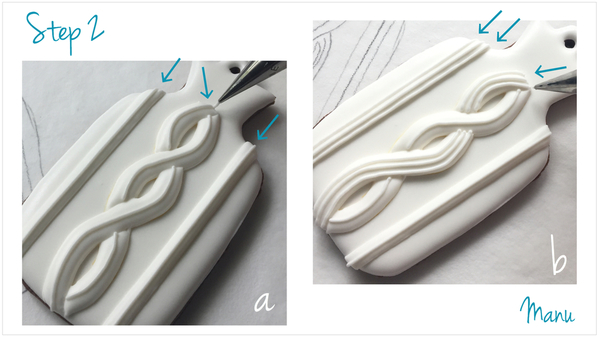

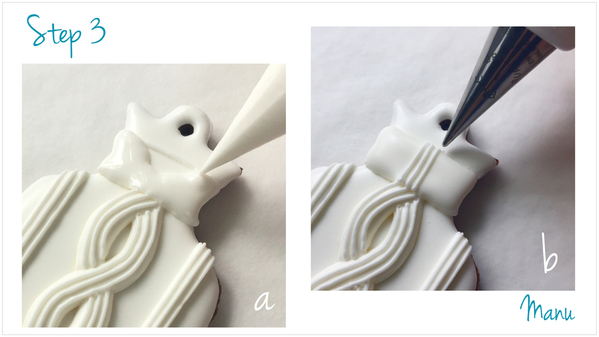
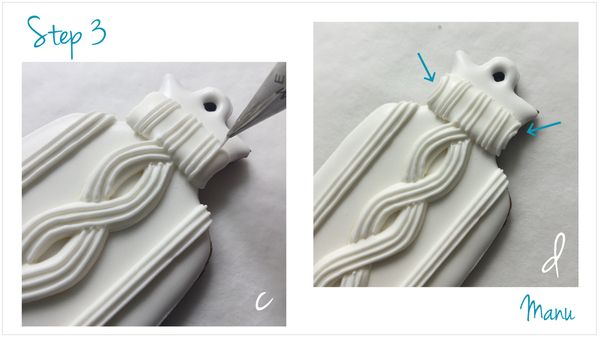
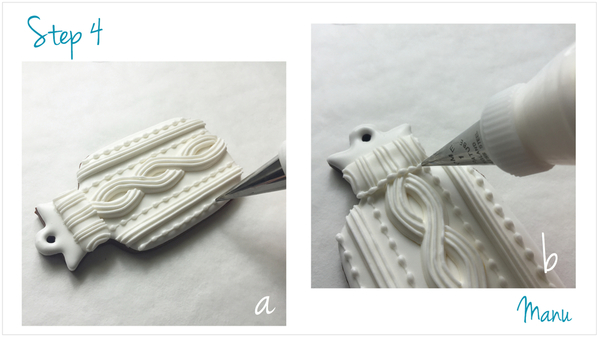


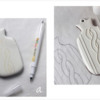
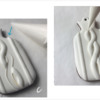

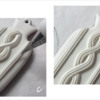



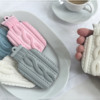
Comments (40)